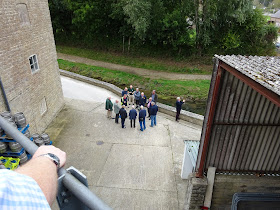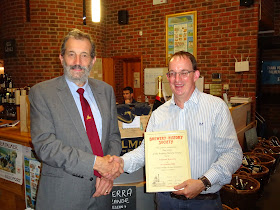You can't beat an old tower brewery. So I was very much looking forward to the Brewery History Society AGM at Palmers. Built in 1794 being a tower brewery is really the least of it when it comes to history as I was to find out on the tour.
 |
I went round with the group lead by Head Brewer Darren Batten. Though you can't tell from the first photo we started at the top, the best way to see a tower brewery.
 |
| This is high up you know |
 |
| See? |
Malt comes in sacks, and they prefer 50kg sacks when they can get them as there are less to hoist up! There's a refreshing small number of beers produced and the malt is elegant in its simplicity: mostly pale and crystal with some beers having amber and/or wheat and one with some munich.
I can't say 50kg sacks is something I would approve of at work, but then we have to lift them to waist height to mill them whereas here they can just tip them over:
They still have the steam engine that drove the belts, though the first time it's been used in years was for our visit:
The new mill is a more modest affair and they don't bother with screening the malt nowadays.
The mash tun us used for brews up to 60 bbl, with annual output being around 7,000bbl.
..
There's a lovely copper grant:
They now have an external wort boiler:
So no more shovelling coal in under the copper:
The hops are mostly Goldings, First Gold and Styrian Goldings, with a small amount of Citra used for a new keg beer.
The hot water from it was discharged straight into the river which, after they'd been doing it for a century or so, the Environment Agency objected to. The Head Brewer seemed a bit annoyed about this. I'd be delighted to switch to a paraflow myself, as I'm sure were the people who had to scrub the cooler clean for an hour each side after use!
The fermenting vessels are also open:
 |
| These are cut down old cider vats |
 |
| Check out the temperature probes! |
The yeast came from Eldridge Pope in 1976.
They use a lot of 4.5 gallon pins, which they sell for exactly half the price of a 9 gallon firkin to encourage their pub tenants to focus on beer quality.
They got the waterwheel going for us too, thought it's also not normally in use. Did the video save thought? Did it bollocks. They have looked into using the waterwheel for electricity generation but sadly it's not cost effective.
The weird cowl on the roof is to help vent the steam from the open copper. It needs the right wind direction to work well though!
You can just see a bit of thatch on the roof on the right:
After lunch we went to the brewery shop where the prestigious BHS certificate was presented by the Chairman to the Head Brewer.
And there was a chance to stock up on some excellently bottled beers:



























7,000 hl a year isn't really very much, and is in the awkward zone just above the threshold where the Progressive Beer Duty relief starts to be withdrawn.
ReplyDeleteInteresting to see they're making a big push on pins to maintain quality.
7,000 bbl but still, not a huge amount. Some of the surviving regionals are surprisingly small. They do have 53 pubs though.
DeleteI was a bit horrified to hear about the pins as it's practically twice as much work to shift the same amount of beer as they would in firkins, but I do like the commitment to quality cask.